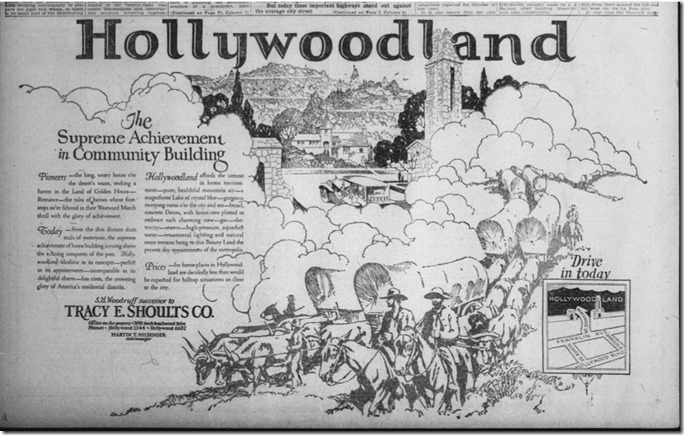
An ad for Hollywoodland, October 1923.
On March 31, 1923, owners of a new hillside development in the Hollywood Hills called Hollywoodland announced the opening of their elaborate new tract in stories run in Los Angeles and Hollywood newspapers. For all the syndicate partners, it represented the pinnacle of their real estate careers in hyperbole as well as class, the first tract to sell a lifestyle of glamour and success. Hollywoodland would be as much about selling ambition and making it as it would be in promoting a humble family home location.
Hollywoodland perfectly encapsulated the lives and careers of its five owners, men who had risen from modest means to achieve wealth and power. Savvy in real estate and business promotion, all were as shrewd in crafting career personas to build their empires. Behind the scenes, these dreamers and schemers plotted their rise up the ladders of success, achieving renown and respect from other hard-nosed businessmen.
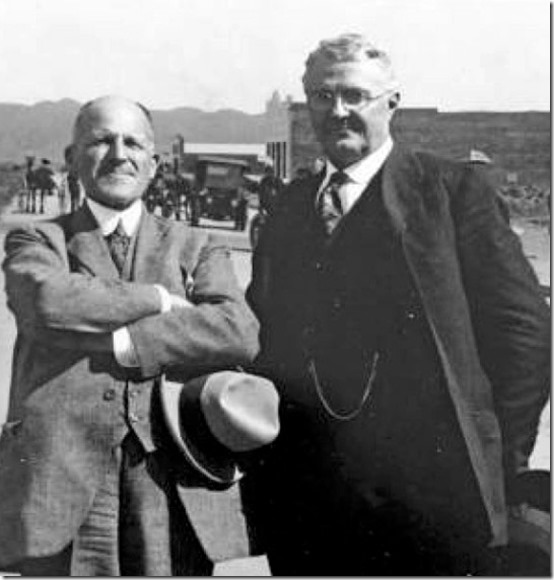
Moses H. Sherman and Harry Chandler in an undated photo.
Of the five, head developer Tracey Shoults remained the most circumspect and reserved throughout his career. Steady and dependable, he rose through the ranks as a real estate salesman. Beginning his career selling individual homes and small plots in South Los Angeles in the early 1900s, Shoults had risen to sales manager of the Garden Acres tract for the Neil McCarthy company by 1914. In 1920, Shoults headed development syndicates, this time in the Los Angeles mid-city area, selling the upscale Marlborough Square, Windsor Heights and New Windsor Square tracts as well as the West Hollywood Tract. Moses H. Sherman, Eli P. Clark, and Harry Chandler recognized his prowess, appointing Shoults head of the glamorous new subdivision.
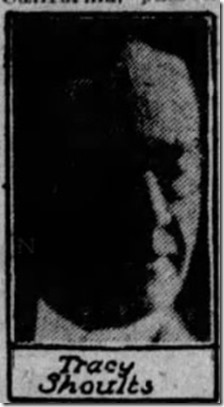 S.H. Woodruff assisted Shoults as second in command of the sprawling project. Woodruff, born to a wealthy family in Michigan in 1876, was the somewhat shady wheeler dealer of the group. He moved with his family to Buffalo, New York, in the 1890s, becoming a successful architect and builder of churches, businesses and factories, many of which survive. After some questionable business decisions, Woodruff and his family immigrated to San Francisco after the 1906 earthquake, where he constructed apartment buildings, hotels, and banks but also suffered legal troubles. Opening an office in the Bryson Apartments in 1913, Woodruff settled permanently in Los Angeles in 1916, looking to rebuild his reputation. By 1920, he joined the Tracey Shoults Co., supervising architects and construction, his focus at Hollywoodland.
S.H. Woodruff assisted Shoults as second in command of the sprawling project. Woodruff, born to a wealthy family in Michigan in 1876, was the somewhat shady wheeler dealer of the group. He moved with his family to Buffalo, New York, in the 1890s, becoming a successful architect and builder of churches, businesses and factories, many of which survive. After some questionable business decisions, Woodruff and his family immigrated to San Francisco after the 1906 earthquake, where he constructed apartment buildings, hotels, and banks but also suffered legal troubles. Opening an office in the Bryson Apartments in 1913, Woodruff settled permanently in Los Angeles in 1916, looking to rebuild his reputation. By 1920, he joined the Tracey Shoults Co., supervising architects and construction, his focus at Hollywoodland.
Los Angeles Times publisher Harry Chandler served as an integral part of the team for the free publicity his newspaper could offer. Born 1864 in New Hampshire, Chandler moved west for his health after graduating from Dartmouth College. While working in fruit fields, he founded a company to deliver the produce, soon becoming responsible for delivering several of the city’s morning newspapers. Chandler met and ingratiated himself with Times publisher Harrison Gray Otis, who soon named him the Times’ general manager. After the death of his first wife, Chandler married Otis’ daughter, Marion, in 1894, and began his climb up the Times’ leadership board, eventually becoming publisher in 1917 with Otis’ death. Following in his father-in-law’s footsteps, he invested in Sherman and Clark real estate developments, offering them a multitude of advertorials promoting the tracts in order to boost sales.
Clark and Sherman acted as a team in their business and real estate endeavors, thanks to their connection as brothers-in-laws and their swift, sure minds. Laconic and observant Clark complemented the personable and articulate Sherman perfectly.
Born in Iowa City, Iowa, in 1847 to prosperous farmers, Clark trained as a teacher before moving to Prescott, Arizona. By 1875, he served as auditor of the Arizona Territory while also running a successful lumber business. Clark helped organize the Atlantic and Pacific Railroad, becoming wealthy. In 1891, he migrated to Los Angeles to join brother-in-law Sherman in operating and constructing electric railways.
Born in West Rupert, Vermont, in 1853, Sherman obtained a teaching certificate and taught in New York and Wisconsin before ill health led him to move west to Arizona in 1874. Sherman rose quickly as a teacher, first to principal and then to state superintendent of public instruction in 1879, before being named adjutant-general of the Arizona Territory in 1883. Sherman invested in land, mines, and cattle while founding banks and water companies, acquiring great wealth along the way. In 1887, Sherman constructed a street railway in Arizona before migrating to Los Angeles in 1890.
Sherman began purchasing and consolidating horse and cable car lines, incorporating the Los Angeles Consolidated Electric Railway Company, the first electric railway, in November, 1890, with Clark. While taking control of other rail lines, the two men quietly bought property along or near transportation systems, biding time to develop them as real estate subdivisions. Though they would lose control of the Consolidated Electric to Henry Huntington and other investors, the two men remained major stockholders and directors of this and later the Pacific Electric.
Over time, Sherman and Clark constructed rail lines from downtown Los Angeles to Hollywood, West Hollywood, Sawtelle, Westgate, Santa Monica, Venice, and other beach cities through land they owned or through which right of way was donated or paid in bonuses by property owners to bring potential customers to potential new land tracts. Their Los Angeles Pacific Railway instituted the Balloon Route in 1905 taking tourists from downtown to Hollywood, the ocean, and back to entice potential landowners. The March 12, 1905, Los Angeles Herald called Sherman and Clark “..the pioneers of interurban transportation and are endowed with an enterprise and sagacity that would command fortune anywhere.”
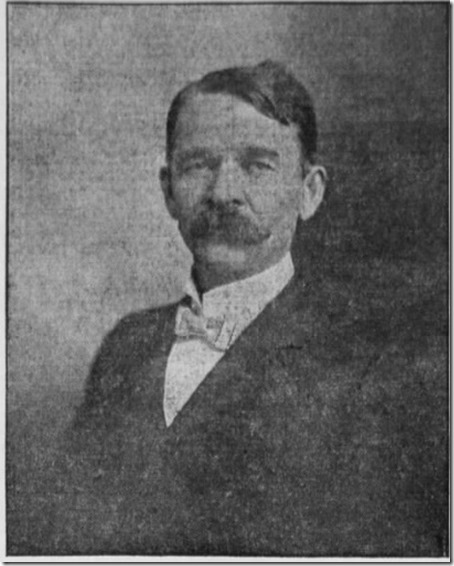
Eli P. Clark in an undated photo.
Astute when it came to real estate, Sherman and Clark joined in several important real estate partnerships over the decades before promoting their own luxurious tract. In 1901, the two men helped organize the Los Angeles Pacific Boulevard and Development Company with H. J. Whitley, Griffith J. Griffith, and F. H. Rindge to purchase land for development north of Hollywood’s Prospect Boulevard west of Highland Avenue, both of which were serviced by Sherman and Clark’s streetcar line. The November 18, 1901, Los Angeles Evening Press stated “the purpose of this corporation is to boom Hollywood, to make it an attractive suburban town.” The syndicate purchased 165 acres north of Prospect for a tract they named the Hollywood Ocean View Tract, that would later include such buildings as the Hollywood Hotel, Yamashiro’s, and the Magic Castle on former plots.
In 1909, Sherman joined with Chandler, Whitley, H. G. Otis, and O.F. Brandt to purchase 48,000 acres of the Farming and Milling Company on which to eventually establish Van Nuys, Marian (Reseda), and Owensmouth (Canoga Park) out in the wide open and sparsely populated San Fernando Valley. With Sherman’s help, Henry E. Huntington extended the Pacific Electric Railway from Hollywood over the Cahuenga Pass to North Hollywood and then on to Van Nuys to facilitate sales.
Sherman and Clark acquired the land on which Hollywoodland would be constructed back in 1905. An article in the December 22, 1968, Times reported that the eastern half of what became Hollywoodland first appeared on a map in 1884 when the federal government issued a patent to the Southern Pacific Railroad, which sold the land in September 26, 1890 to Mrs. Julia E. Lord, wife of Isaac W. Lord, who helped found the Los Angeles Railway. On June 2, 1896, the two Lords sued the Cahuenga Gold Mining, Milling and Irrigation Company to quiet the title on 640 acres that they were not mining. After a court fight, the Lords won the right to the land, with the Lords establishing the Los Angeles Porphyry Co. to quarry the land for stone. Mrs. Lord sold Sherman and Clark the 640 acres for $10,000, per the July 9, 1905 Times. The land gained the name the Sherman and Clark Ranch, and they allowed the Los Angeles Stone Co. to quarry stone out of Brush Canyon, which is now known as Bronson Canyon.
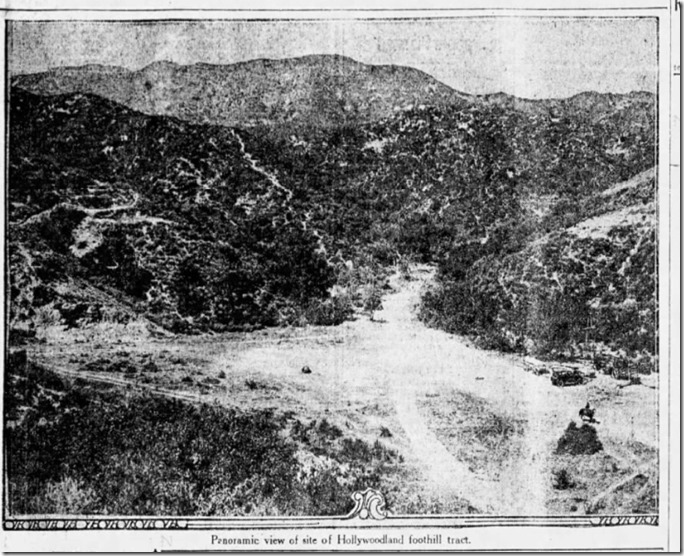
The Hollywoodland entrance, March 31, 1923, Los Angeles Evening Express.
By 1923, Sherman and Clark considered conditions right for subdividing the wooded tract offering “majestic panoramas and splendid vistas” into a charming, lush neighborhood marketed to upper middle class buyers, selling an upscale lifestyle to those who could afford to build on the the sometimes steep but attractive plots starting at $2,000. After a recession in the early 1920s, the United States’ economy was booming. Los Angeles continued exploding in population as the movies and newspapers propagated a land of sunshine and golden dreams to those looking for new beginnings. Working with Shoults, Woodruff, and Chandler, they determined to create a new type of development, one blending both residential and commercial into what is now known as a master planned community, the first themed hillside subdivision anywhere in the country. Their lush neighborhood would offer amenities not even places like Beverly Hills could offer, allowing them to construct “The Castle of Your Dreams,” as a March 1, 1924 story put it.
Inside massive stone gates constructed from stone at the Brush Canyon quarry would stand a small commercial area with stores such as market, barber shop, beauty parlor, and gas station. An imposing English style stable would be erected at the top of Beachwood Drive, with tennis courts and gardens nearby. City bus service would extend to Hollywoodland from Franklin Avenue, and a community jitney would deliver residents to and from their homes to aid commuting to work. These amenities alone offered ease and comfort which no other real estate subdivision could proffer.
Newspaper stories March 31 and April 1 announced that the syndicate had purchased 500 choice acres of Sherman and Clark land on which to create “the Supreme Achievement in Community Building.” Developer Woodruff described the tract to newspapers. “We believe Hollywoodland will become one of the most distinctive home communities in the country… The syndicate…promises to give Los Angeles a most beautiful, most artistic and most ideal homesite… .” To maintain home quality and discourage speculation, buyers would be required to present home plans to an architectural committee. These exclusive touches positioned Hollywoodland as a luxurious jewel, making it the most elaborate and expensive development ever offered by any of the syndicate members.
Little did they know that a simple billboard would later be constructed in November and December 1923. Illuminated on December 8, 1923, the Hollywoodland sign would bring the development worldwide recognition over the next century, further pushing the illusion of glamour and success to gullible tourists and wannabe entertainers.


Two of my 10 favorite films – L.A. CONFIDENTIAL and MULHOLLAND DRIVE – form a kind of “darkness behind the Hollywood veneer” trilogy along with SUNSET BOULEVARD. The 2006 film HOLLYWOODLAND possibly makes this a quartet. Knowing the origin of that mythology is fascinating, thank you.
LikeLike